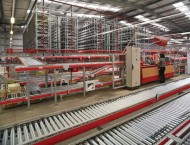 During the current difficult economic period for all industries, particularly those within the materials handling sector, it is essential to maintain and exploit a ‘competitive advantage’ to ensure that even in economic downturns solutions can be found to improve bottom line performance.
During the current difficult economic period for all industries, particularly those within the materials handling sector, it is essential to maintain and exploit a ‘competitive advantage’ to ensure that even in economic downturns solutions can be found to improve bottom line performance.
Warehouse operators not only need to conserve resources in the short term but build upon long-term opportunities in order to grow and adapt to keep up with changing environments, even more so during a recession, by assessing areas for improvement whilst reducing supply chain costs – it is crucial that decision-makers think analytically and overcome challenges in the warehouse constructively during such testing times.
The current economic climate will act as a catalyst for the installation of automated systems within the distribution centre as businesses discover reduced supply chain costs through the role of automation. The development of automation in distribution has come on in leaps and bounds during the past few years with new concepts, better technology and system integration compatibility, enabling warehouse operators to streamline logistics operations, increase efficiency and cut costs more effectively.
Automated systems provide significant added value services and order/despatch sequences that reduce cost throughout a company’s distribution operation, often when manually operated systems are unable to meet order fulfilment demands placed upon them due to high volume throughput for next and same -day delivery.
Long-term benefits of warehouse automation include faster reaction / cycle times, high picking and replenishment accuracy, order fulfilment, manpower savings, store friendly picking, RFID, tracking, tracing, information transparency and visibility with a significant reduction in damaged stock, all leading to a significant reduction in errors and driving down cost as a result. Automated systems are a long term investment with immediate short term gains and now is the right time to invest.
Environmental concerns are always at the forefront of SSI Schaefer’s objectives and customers looking to invest in warehouse automation should work with a supplier that can provide sustainable solutions that will drive down energy costs.
For example, Office Depot is committed to providing sustainable solutions within the business. SSI Schaefer completed the design, supply, manufacture, delivery and installation of a fully functioning Automated Order Fulfillment System for Office Depot’s new distribution centre in Leicester.
Sustainability was a vital element of the build, resulting in the new order fulfillment system being designed using energy saving measures whilst utilising several new technologies to provide a sustainable building for years to come. SSI Schaefer also applied a ‘shutdown system’ during lean periods that closes sections of the conveyor automatically until a carton is detected entering a section.
As a result of lower economic growth during 2009 many companies will start to consider warehouse automation as an alternative option to investing in brand new facilities, removing the necessity for high capital investment in new properties. Warehouse operators should research automated systems that can easily integrate into current facilities and operations, thereby reducing unit distribution costs – this is when the modular approach, recommended by SSI Schaefer, to system building and integration is so important, enabling small and medium sized operations to grow, change, adapt and invest in stages with ease over time.
The modular approach can start with the replacement of conventional shelving with deeper, carton live storage or flow racking, which increases storage capacity and requires a lower rate of replenishment. Phase two could be adding in a paperless picking radio frequency system, placing conveyors at either ends of storage aisles to take picked goods away from the storage area. This could then be converted to a pick-to-light system, introducing ‘automatic picking’, before adding in conveyors and an automatic storage and retrieval system to build up to a goods-to-man system. Finally a full, high-end automation system could be installed that provides automatic case picking, pallet building and product sequencing for example.
If a small or medium sized business operates a manual picking system and just wants to move to a basic paperless system, the initial capital cost is low with minimal disruption as a result of no structural changes to the distribution centre. The long term benefit of this is increased speed and accuracy both in the distribution centre and further down the supply chain.
Perhaps most importantly, any company looking to install an automated system should source a reliable supplier that has a good strong proven track record in providing reliable and innovative solutions with demonstrable longevity. For example, an on-going service and maintenance contract is essential in prolonging the life of any system installed within a distribution centre, reducing the likelihood of prolonged downtime as a result of system failure.
Companies that rely on automation for successful, ongoing, day to day operations cannot afford to be down for any significant length of time.
Other added value services to look for from a potential supplier should include project management, installation and integration of equipment throughout the whole distribution operation, particularly for companies looking to remove costs in the supply chain and centralise within the distribution centre. But perhaps most importantly, the financial stability of a supplier is vital for ongoing long term support, particularly during an uncertain economic climate.
SSI?Schaefer
Tel: 01264 386000
www.ssi-schaefer.co.uk




Comments are closed.